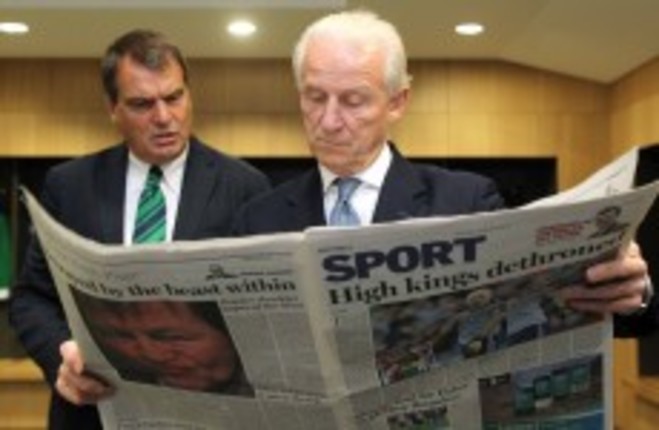1. “McGuigan’s broad popularity was a sizable achievement, pulled off only through repeated and ostentatious displays of neutrality. He refused to have national flags accompany his entrance into the ring. In place of a national anthem, he would have his father sing “Danny Boy” before his bouts. Even his shorts were adorned with a dove of peace. McIlroy enjoys a similar cross-community appeal. But, tellingly, he has acquired it without advertising his impartiality in blazing neon. He has, so far, dodged questions of political affiliation with a shoulder-shrugging casualness that no one from McGuigan’s era could have gotten away with.”
Rory McIlroy’s Major win at the US Open was one of the highlights of the sporting year. But inevitably in the aftermath, the conversation turned towards the politics of the Hollywood kid’s identity. In the New York Times, Niall Stanage looks at how Rory has managed the troublesome issue in public.
2. “Riotous waves pummel José Arias. In the frantic scramble to abandon ship, he zipped his survival suit only to his throat and now the freezing Atlantic is seeping in, stealing his body’s heat. The cold hammers him, a fist inside his head. Seesawing across the ocean, he cannot tell east from west, up from down. At the top of a wave the night sky spins open, then slides away. Buckets of stars spill into the sea. ‘Sálvame, por favor. Sálvame.’”
Ok, so this may have been published in late 2010, but it won the Pulitzer Prize for feature writing this year which is good enough for me. Enjoy Amy Ellis Nutt‘s 20-page spread in the New Jersey Star Ledger on the mysterious sinking of a fishing boat off the state’s coast.
3. “In June last year, a dark rumour began to circulate: Paul Gascoigne had two days to live. There were even stories that the former England footballer was already dead – after a car crash, of pneumonia, from the drink. Nobody wanted to believe the rumours, but there seemed to be a grim inevitability to them. A month later, Gascoigne proved he was alive in bizarre and equally dark circumstances. After Raoul Moat had shot three people, killing one, Gascoigne jumped in a taxi with a box of chicken, can of lager, fishing rod and dressing gown, and announced to the world that he was there to rescue his old friend from himself. It wasn’t a good year for Gascoigne publicity-wise. But then it’s been a long time since it has been.”
He was one of his generation’s greatest talents but life after football has been anything but simple for Paul Gascoigne. Simon Hattenstone met him in October for the Guardian.
4. “Today, in this cemetery in the foothills of the Wicklow mountains, the Tour is wearing its heart on its sleeve. The Tour’s dignitaries are here today to celebrate the Irish who have participated in the Tour de France and who have contributed to the Tour’s rich history. Laurence Roche and Martin Earley and Paul Kimmage and Ian Moore, unsung heroes of the peloton. Sean Kelly, who once got to wear the yellow jersey but was more at home in the sprinters’ green jersey, which he won four times. Stephen Roche, who won the race outright in that magical Summer of 1987. And – the reason they are here in this cemetery – Shay Elliott, domestique to Jacques Anquetil. The first Irishman to ride the Tour de France. The first to win a stage. And the first to wear its fabled maillot jaune.”
Paying tribute to the great Shay Elliott, Cyclismas’s FMK explores the Dubliner’s legacy in Irish cycling.
In December, the New York Times published John Branch‘s brilliant three-part series on the life and death of ice hockey enforcer Derek Boogaard. A must-read feature of the physical and psychological consquences of violence in high-impact sports.
6. “But you need to realise that it’s not what Cassidy said that has seen him dropped, it’s the fact he said it. So much of the new Donegal has been built on unity. Given their style of play and their reputation it had to be that way, from every man working for each other in tactics that had the physicality and imagination of shoveling coal, to a group renowned for off-field indiscretion all buying into a new way of life to such an extent that they even gave up their pre-championship night out for a trip to the Scottish league cup final way back in March. There was a trust and a bond amongst this Donegal team across 2011 that helped them come from nowhere to be genuine contenders and one of the core values of the squad was what happens on Donegal duty stays on Donegal duty.”
The Kevin Cassidy saga dominated GAA headlines in November. Ewan MacKenna’s analysis for EircomSport cut right to the nub of the whole mess.
7. Only once did I feel a brief flicker of hallucinatory terror. We were in a pizza parlor, in the friendly Cobble Hill section of Brooklyn, and I was having difficulty deciding which slice to purchase because even though my stomach said “plain slice” my mind begged for “chicken jalapeño with shredded garlic knots,” which wasn’t even available but, dammit, it should have been that day. It didn’t feel like an unreasonable amount of time had passed. Then a slice of white pie was whooshed out of the giant oven by the pizzaman, and the gurgling cheese appeared angry with me. Maybe I was holding up the line. I ducked behind the soda fountain to refocus my fritzy thoughts for a couple extra minutes until that ricotta stopped messing with me. I ordered two plain slices quickly, then added on a slice of white because I felt the need to assert myself. ‘Hey, white pizza. I eat you. You don’t eat me.’”
In 1970, Dock Ellis of the Pittsburgh Pirates famously pitched an entire game under the influence of LSD without giving up a single hit. In July, Deadspin editor-in-chief AJ Daulerio attempted to recreate the feat on the XBox. Sports journalism at its finest.
8. “Some people mean more together than they do apart, whatever the stage. Churchill and Hitler. Bogart and Bacall. Ali and Frazier. And for all the deserved accolades for Muhammad Ali, I’ve always believed that each at his best, Joe Frazier, who died Monday night at age 67, was the better fighter. And the better man.”
In November, the world of boxing lost one of its heavyweight heroes, Smokin’ Joe Frazier. There were plenty of worthy tributes penned in the days following Frazier’s death but few which began as controversially as Dave Anderson‘s for the New York Times.

